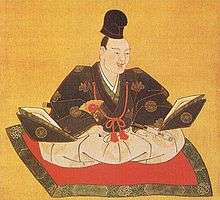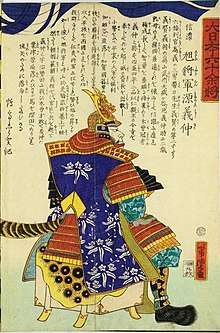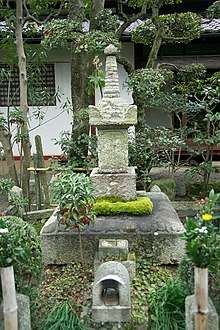Minamoto no Yoshinaka
Minamoto no Yoshinaka (源 義仲, 1154 – February 21, 1184), Kiso no Yoshinaka (木曾 義仲), or Lord Kiso[1] was a general of the late Heian period of Japanese history. A member of the Minamoto samurai clan, Minamoto no Yoritomo was his cousin and rival during the Genpei War between the Minamoto and the Taira clans. Yoshinaka was born in Musashi province. His Dharma name was Tokuon'in Gisan Senkō (徳音院義山宣公).



Yoshinaka's father, Minamoto no Yoshikata, was killed by Minamoto no Yoshihira in 1155. Yoshihira sought to kill Yoshinaka also, but the latter escaped to Shinano Province.[2][3]:11
He was raised with Nakahara Shiro who was his milk brother (Shiro's mother Chizuru nursed both Yoshinaka and Shiro). This Shiro would later become Imai Kanehira, Yoshinaka's best friend and most loyal retainer.
Yoshinaka later changed his name from Minamoto to Kiso (木曾), to reflect the Kiso Mountains where he was raised.[4]
In 1181, Yoshinaka received Prince Mochihito's call to the members of the Minamoto clan to rise against the Taira. Yoshinaka entered the Genpei War raising an army and invading Echigo Province. He then defeated a Taira force sent to pacify the area.[5]
In 1183 a Taira army captured Hiuchi.[6]
In 1183, Yoshinaka was confronted by Minamoto no Yoritomo, whose army had entered Shinano. The two reconciled and resolved to unite against the Taira. Yoshinaka then sent his son to Kamakura as a hostage.[3]
However, having been shamed, Yoshinaka was now determined to beat Yoritomo to Kyoto, defeat the Taira on his own, and take control of the Minamoto for himself.
Yoshinaka defeated the army of Taira no Koremori at the Battle of Kurikara Pass and marched to Kyoto. The Taira retreated out of the capital, taking the child Emperor Antoku with them. Yoshinaka's army entered the capital with the cloistered Emperor Go-Shirakawa. Go-Shirakawa then issued a mandate for Yoshinaka to join with Yukiiye in "destroying Munemori and his army".[5]:293–294
The emperor bestowed upon Yoshinaka the title of Asahi Shōgun (旭将軍).
Yoshinaka plotted with Yukiie in "setting up a government in their own northern province". Learning Go-Shirakawa had sought help from his cousin Yoritomo, Yoshinaka seized the cloistered emperor and burned his palace. Yoritomo ordered his brothers Yoshitsune and Noriyori to destroy Yoshinaka.[5]:296
Yoshinaka was driven out of Kyoto and killed by his cousins at the Battle of Awazu in Ōmi Province (present-day Shiga Prefecture) along with Kanehira.[5]:296–297 With night coming and with many enemy soldiers chasing him, he attempted to find an isolated spot to kill himself. However, the story says that his horse became trapped in a field of partly frozen mud and his enemies were able to approach him and kill him.[4]:66
He was buried in Ōtsu, in Ōmi; a temple was built in his honor during the later Muromachi period. Its name, Gichū-ji, has the same two kanji as his given name. Kanehira's grave is also in Otsu, but it is not close to Yoshinaka's. The Edo period poet Matsuo Bashō, pursuant to his last wishes, was buried next to Minamoto no Yoshinaka in Gichū-ji.
Minamoto no Yoshinaka is one of many main characters in the Kamakura period epic, the Tale of Heike. The story of Yoshinaka and Kanehira is fairly well known in Japan; it is also the subject of the Noh play Kanehira, in which Kanehira's tormented ghost describes his and Yoshinaka's death, and his wish to go to the other side.
| Wikimedia Commons has media related to Minamoto no Yoshinaka. |
See also
References
- The Tales of the Heike. Translated by Burton Watson. Columbia University Press. 2006. p. 72, 193. ISBN 9780231138031.
- Sato, Hiroaki (1995). Legends of the Samurai. Overlook Duckworth. p. 114. ISBN 9781590207307.
- Turnbull, Stephen (1987). Battles of the Samurai. Arms and Armour Press. pp. 14–15. ISBN 0853688265.
- Turnbull, Stephen (1977). The Samurai, A Military History. MacMillan Publishing Co., Inc. p. 55. ISBN 0026205408.
- Sansom, George (1958). A History of Japan to 1334. Stanford University Press. p. 291, 293. ISBN 0804705232.
- Turnbull, Stephen (1998). The Samurai Sourcebook. Cassell & Co. p. 201. ISBN 1854095234.
Further reading
- Yoshinaka's life is described in some detail in S. Turnbull's book The Samurai (1977) pages 55 to 66).